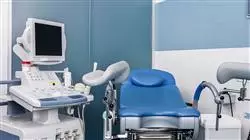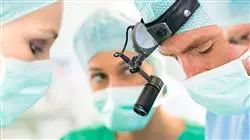University certificate
The world's largest faculty of nursing”
Introduction to the Program
A Postgraduate diploma created so that you can offer the best nursing care in the most demanding Assisted Reproduction Units"

The Postgraduate diploma student will learn in detail the operation of an Assisted Reproduction Clinic. Special emphasis will be placed on all those basic tests necessary for the initiation and continuation of treatment, finding out the fundamental role of the nursing service: assistance, management and education.
In addition, we will study the different techniques performed in the AR Laboratory, aimed at achieving pregnancy in patients with fertility problems both female and male, the characteristics of the surgical area and the work in it and the intervention of the nursing staff in preoperative, intraoperative and postoperative moments.
In this Postgraduate diploma, special importance will be given to the intervention in surgical procedures carried out in Assisted Reproduction Units and to all aspects of the work that nursing professionals perform in this environment. From the most complex protocols to the simplest ones, equipment, clothing, etc.
With this Postgraduate diploma you will be able to combine a high intensity specialization with your professional and personal life, achieving your goals in a simple and real way"
This Postgraduate diploma in The Operating Room and the Assisted Reproduction Consultation for Nursing offers the characteristics of a high-level scientific, teaching and technological course. These are some of its most notable features:
- The latest technology in online teaching software
- A highly visual teaching system, supported by graphic and schematic contents that are easy to assimilate and understand
- Practical cases presented by practising experts
- State-of-the-art interactive video systems
- Teaching supported by telepractice
- Continuous updating and recycling systems
- Autonomous learning: full compatibility with other occupations
- Practical exercises for self-evaluation and learning verification
- Support groups and educational synergies: questions to the expert, debate and knowledge forums
- Communication with the teacher and individual reflection work
- Content that is accessible from any fixed or portable device with an Internet connection
- Supplementary documentation databases are permanently available, even after the course
Acquire the specific skills of nursing in the surgical environment in Assisted Reproduction and perform with the solvency of a high-level professional"
Our teaching staff is made up of professionals from different fields related to this specialty. In this way, TECH makes sure to offer the training update objective it intends. A multidisciplinary team of professionals trained and experienced in different environments, who will develop the theoretical knowledge efficiently, but, above all, will put at the service of the course the practical knowledge derived from their own experience: one of the differential qualities of this specialization.
This mastery of the subject is complemented by the effectiveness of the methodological design of this Postgraduate diploma in The Operating Room and the Assisted Reproduction Consultation for Nursing. Developed by a multidisciplinary team of experts, it integrates the latest advances in educational technology. In this way, you will be able to study with a range of comfortable and versatile multimedia tools that will give you the operability you need in your specialization.
The design of this program is based on Problem-Based Learning: an approach that conceives learning as a highly practical process. To achieve this remotely, TECH will use telepractice: with the help of an innovative interactive video system and Learning from an Expert, the student will be able to acquire the knowledge as if they were facing the scenario they are learning at that moment. A concept that will allow students to integrate and memorize what they have learnt in a more realistic and permanent way.
The learning of this Postgraduate diploma is supported by the best didactic means and the best online resources to guarantee that your efforts will have the best possible results"

Our innovative telepractice concept will give you the opportunity to learn through an immersive experience: “Learning from an expert”. A system of recognized effectiveness for the integration of knowledge"
Why study at TECH?
TECH is the world’s largest online university. With an impressive catalog of more than 14,000 university programs available in 11 languages, it is positioned as a leader in employability, with a 99% job placement rate. In addition, it relies on an enormous faculty of more than 6,000 professors of the highest international renown.

Study at the world's largest online university and guarantee your professional success. The future starts at TECH”
The world’s best online university according to FORBES
The prestigious Forbes magazine, specialized in business and finance, has highlighted TECH as “the world's best online university” This is what they have recently stated in an article in their digital edition in which they echo the success story of this institution, “thanks to the academic offer it provides, the selection of its teaching staff, and an innovative learning method aimed at educating the professionals of the future”
A revolutionary study method, a cutting-edge faculty and a practical focus: the key to TECH's success.
The most complete study plans on the university scene
TECH offers the most complete study plans on the university scene, with syllabuses that cover fundamental concepts and, at the same time, the main scientific advances in their specific scientific areas. In addition, these programs are continuously being updated to guarantee students the academic vanguard and the most in-demand professional skills. In this way, the university's qualifications provide its graduates with a significant advantage to propel their careers to success.
TECH offers the most comprehensive and intensive study plans on the current university scene.
A world-class teaching staff
TECH's teaching staff is made up of more than 6,000 professors with the highest international recognition. Professors, researchers and top executives of multinational companies, including Isaiah Covington, performance coach of the Boston Celtics; Magda Romanska, principal investigator at Harvard MetaLAB; Ignacio Wistumba, chairman of the department of translational molecular pathology at MD Anderson Cancer Center; and D.W. Pine, creative director of TIME magazine, among others.
Internationally renowned experts, specialized in different branches of Health, Technology, Communication and Business, form part of the TECH faculty.
A unique learning method
TECH is the first university to use Relearning in all its programs. It is the best online learning methodology, accredited with international teaching quality certifications, provided by prestigious educational agencies. In addition, this disruptive educational model is complemented with the “Case Method”, thereby setting up a unique online teaching strategy. Innovative teaching resources are also implemented, including detailed videos, infographics and interactive summaries.
TECH combines Relearning and the Case Method in all its university programs to guarantee excellent theoretical and practical learning, studying whenever and wherever you want.
The world's largest online university
TECH is the world’s largest online university. We are the largest educational institution, with the best and widest online educational catalog, one hundred percent online and covering the vast majority of areas of knowledge. We offer a large selection of our own degrees and accredited online undergraduate and postgraduate degrees. In total, more than 14,000 university degrees, in eleven different languages, make us the largest educational largest in the world.
TECH has the world's most extensive catalog of academic and official programs, available in more than 11 languages.
Google Premier Partner
The American technology giant has awarded TECH the Google Google Premier Partner badge. This award, which is only available to 3% of the world's companies, highlights the efficient, flexible and tailored experience that this university provides to students. The recognition as a Google Premier Partner not only accredits the maximum rigor, performance and investment in TECH's digital infrastructures, but also places this university as one of the world's leading technology companies.
Google has positioned TECH in the top 3% of the world's most important technology companies by awarding it its Google Premier Partner badge.
The official online university of the NBA
TECH is the official online university of the NBA. Thanks to our agreement with the biggest league in basketball, we offer our students exclusive university programs, as well as a wide variety of educational resources focused on the business of the league and other areas of the sports industry. Each program is made up of a uniquely designed syllabus and features exceptional guest hosts: professionals with a distinguished sports background who will offer their expertise on the most relevant topics.
TECH has been selected by the NBA, the world's top basketball league, as its official online university.
The top-rated university by its students
Students have positioned TECH as the world's top-rated university on the main review websites, with a highest rating of 4.9 out of 5, obtained from more than 1,000 reviews. These results consolidate TECH as the benchmark university institution at an international level, reflecting the excellence and positive impact of its educational model.” reflecting the excellence and positive impact of its educational model.”
TECH is the world’s top-rated university by its students.
Leaders in employability
TECH has managed to become the leading university in employability. 99% of its students obtain jobs in the academic field they have studied, within one year of completing any of the university's programs. A similar number achieve immediate career enhancement. All this thanks to a study methodology that bases its effectiveness on the acquisition of practical skills, which are absolutely necessary for professional development.
99% of TECH graduates find a job within a year of completing their studies.
Postgraduate Diploma in Operating Room and Assisted Reproduction Consultation for Nursing
Prepare yourself to be a reference in the field of assisted reproduction with this Postgraduate Diploma in Operating Room and Assisted Reproduction Consultation for Nursing program, offered by TECH Global University in online modality. Discover how to provide specialized and quality care in the area of assisted reproduction, contributing to the well-being of patients and the advancement of science. Assisted reproduction is a constantly evolving discipline that requires highly trained professionals. With our program, you will be trained in the latest techniques and procedures used in the operating room and assisted reproduction consultation, acquiring the necessary knowledge to assist the medical team and provide specialized Nursing care.
Enroll now and start online.
At TECH Global University, we understand the importance of flexibility and accessibility in education. That is why we offer this program in online mode, so you can study from anywhere and adapt it to your schedule. Our online platform will provide you with all the necessary tools to follow the program in an interactive and participative way. The Postgraduate Diploma in Operating Room and Assisted Reproduction Consultation for Nursing will allow you to deepen in fundamental aspects such as treatment monitoring, medication management, emotional support to patients and management of surgical procedures. In addition, you will have the guidance of expert professionals in the field and you will be able to interact with other students, enriching your academic experience. Become a competent professional trained to provide Nursing care in the field of assisted reproduction. Enroll in the Postgraduate Diploma program in Operating Room and Assisted Reproduction Consultation for Nursing at TECH Global University and stand out in a field in constant growth and labor demand. Your quality preparation is just a click away.







